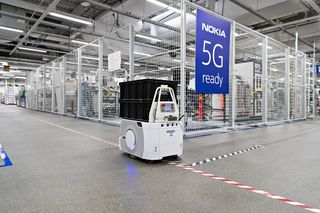Nokia offers standalone 5G private wireless gear to enterprises
Industrial networks set to benefit from standalone 5G

Nokia has made its first Standalone 5G (SA 5G) products available to private networking customers, paving the way for the adoption of revolutionary industrial applications that require reliable, low latency connectivity.
Enterprise services are set to be a major source of new revenue for operators who have had to cope with declines in tradition sources of income such as voice.
While many businesses will use commercial 5G networks, larger enterprises will look at private wireless deployments. This allows them to dictate the technology used and the speed of rollout – either with or without an operator.
- UK 5G speeds slower than rest of world
- 5G in the UK: everything you need to know
- Operators reach £1bn shared rural network deal
Nokia enterprise 5G
Private wireless is already possible with 4G but 5G has the potential to transform industrial connectivity.
Commercial deployments to date have relied on Non-standalone 5G (NSA 5G) which uses new radio technologies but still relies on a 4G core. SA 5G makes use of cloud-based, virtualised cores that allow network resources to be moved around dynamically and process data closer to the point of collection.
This would allow certain industrial and mission critical applications to be supported by mobile networks for the first time.
Manufacturing, utilities and transportation are the most enthusiastic industries, with the public sector also excited for the potential of 5G applications. Intelligent video, AR and VR training, and remote-controlled machinery are all viewed as important 5G applications.
Are you a pro? Subscribe to our newsletter
Sign up to the TechRadar Pro newsletter to get all the top news, opinion, features and guidance your business needs to succeed!
The enterprise networking market has become increasingly important to Nokia, which is competing with the likes of Ericsson and Huawei.
“Private wireless connectivity is central to our customers realizing their long-term digital transformation goals,” said Raghav Sahgal, President of Nokia Enterprise. “By delivering 5G SA, we’re paving the way to accelerate digitalization in the most demanding of use cases such as automotive manufacturing, where cloud, robotics and autonomous machine operations create mission-critical demands for reliable low latency and high data rate.”
Nokia already has 180 private wireless customers, of which 30 have 5G arrangements – including Toyota and Deutsche Bahn. One of the pillars of the Finnish network giant’s 5G strategy has been to allow customers to maximise their existing hardware and spectrum assets and it has assured customers that updates to its LTE portfolio will ensure that this is still the case.
“We recognize that 4.9G/LTE, which handles more than 85 percent of industrial applications, will continue to be the foremost private wireless solution for some time,” added Sahgal. “With this announcement we bring the best of both worlds. We are offering customers the choice to start with 4.9G/LTE, and evolve to 5G as the ecosystem matures, or alternatively, to go ‘direct to 5G’ – validating the technology and driving OEM and industrial asset vendors to develop a thriving 5G ecosystem.”
- Here are the best 5G phone deals
Steve McCaskill is TechRadar Pro's resident mobile industry expert, covering all aspects of the UK and global news, from operators to service providers and everything in between. He is a former editor of Silicon UK and journalist with over a decade's experience in the technology industry, writing about technology, in particular, telecoms, mobile and sports tech, sports, video games and media.
